Towards Dependence of Tropical Cyclone Intensity on Sea Surface Temperature and Its Response in a Warming World
Abstract
:1. Introduction
2. Theoretical Background
3. Methods Employed and Datasets Used
3.1. Methodology
3.1.1. Computation of Sustained Wind Speeds
3.1.2. Warmer World Scenario with Increased CO2
3.2. Data Used
3.2.1. Reanalysis Data
3.2.2. Climate Model Data
4. Results and Discussion
4.1. Development of a Linear Vmax Model and Its Validation against an Established Model
4.2. Understanding the Role of Sustained Wind Speed through Enthalpy
4.3. Spatial Distribution of SST and Comparison with that of Vmax
4.4. Application of Linear Model Outputs to HadCM3 Model
5. Model Application on Temporal Resolution
5.1. Patterns in the VmaxNew
5.1.1. North Indian Ocean
5.1.2. Southwest Pacific Ocean
5.1.3. North Atlantic Ocean
5.1.4. Northwest Pacific
5.1.5. Southern Indian Ocean
5.2. Time Series Trends
- (1)
- The Southwest Pacific: Simulated TC wind speed VmaxNew reveals a steep increase since 1910 until 2014 in the Southwest Pacific (Figure 9). A period of 161 years between 1854 to 2014 shows steady fluctuations between 67 to 70 m/s wind speed.
- (2)
- The South Indian Ocean: Trends in VmaxNew in the South Indian Ocean (Figure 10) show a lull period between 1854 and 1940 followed by a year of sharp rise and then fall. VmaxNew since 1970 onwards illustrates a sharp rise from 59 m/s to 63 m/s.
- (3)
- The Northwest Pacific: Graph of VmaxNew in the Northwest Pacific (Figure 11) shows that there has been an interesting long term cycle of rise and fall from 1854 to 1980 after which the TC strengthened sharply. The least active year in terms of TC strength was 1919.
- (4)
- The North Indian Ocean: The North Indian Ocean looks like an active region accommodating various intense tropical storms since early 1990 (Figure 12). Although there was a comparatively dormant period during 1895 to 1990, a dramatic rise is observed thereafter.
- (5)
- The North Atlantic Ocean: The North Atlantic Ocean seems to drift from moderately active to a dramatically active TC region, in terms of the associated destructive potential (Figure 13). Year 2005 and 2010 marked years of severe tropical storms. The period prior to 1910 was of low cyclone activity.
6. Summary and Future Work
Supplementary Files
Supplementary File 1Acknowledgments
Author Contributions
Conflicts of Interest
References
- Bister, M.; Emanuel, K.A. Low frequency variability of tropical cyclone potential intensity 1. Interannual to interdecadal variability. J. Geophys. Res. Atmos. 2002, 107. [Google Scholar] [CrossRef]
- Emanuel, K. Environmental factors affecting tropical cyclone power dissipation. J. Clim. 2007, 20, 5497–5509. [Google Scholar] [CrossRef]
- Emanuel, K. Increasing destructiveness of tropical cyclones over the past 30 years. Nature 2005, 436, 686–688. [Google Scholar] [CrossRef] [PubMed]
- Bryan, G.H.; Rotunno, R. The maximum intensity of tropical cyclones in axisymmetric numerical model simulations. Mon. Weather Rev. 2009, 137, 1770–1789. [Google Scholar] [CrossRef]
- Emanuel, K.A. An air sea interaction theory for tropical cylones. Part I: Steady-state maintenance. J. Atmos. Sci. 1986, 43, 585–604. [Google Scholar] [CrossRef]
- Emanuel, K.A. The maximum intensity of hurricanes. J. Atmos. Sci. 1988, 45, 1143–1155. [Google Scholar] [CrossRef]
- Emanuel, K.A. Sensitivity of tropical cyclones to surface exchange coefficients and a revised steady-state model incorporating eye dynamics. J. Atmos. Sci. 1995, 52, 3969–3976. [Google Scholar] [CrossRef]
- Simpson, J.; Ritchie, E.; Holland, G.J.; Halverson, J.; Stewart, S. Mesoscale interactions in tropical cyclone genesis. Mon. Weather Rev. 1997, 125, 2643–2661. [Google Scholar] [CrossRef]
- Rotunno, R.; Emanuel, K.A. An air-sea interaction theory for tropical cyclones. Part II: Evolutionary study using a non-hydrostatic axisymmetrical numerical-model. J. Atmos. Sci. 1987, 44, 542–561. [Google Scholar] [CrossRef]
- Persing, J.; Montgomery, M.T. Is environmental CAPE important in the determination of maximum possible hurricane intensity? J. Atmos. Sci. 2005, 62, 542–550. [Google Scholar] [CrossRef]
- Demaria, M.; Kaplan, J. Sea-surface temperature and the maximum intensity of Atlantic tropical Cyclones. J. Clim. 1994, 7, 1324–1334. [Google Scholar] [CrossRef]
- Zeng, Z.; Wang, Y.; Wu, C.-C. Environmental dynamical control of tropical cyclone intensity—An observational study. Mon. Weather Rev. 2007, 135, 38–59. [Google Scholar] [CrossRef]
- Whitney, L.D.; Hobgood, J.S. The relationship between sea surface temperatures and maximum intensities of tropical cyclones in the eastern North Pacific Ocean. J. Clim. 1997, 10, 2921–2930. [Google Scholar] [CrossRef]
- Saunders, M.A.; Harris, A.R. Statistical evidence links exceptional 1995 Atlantic hurricane season to record sea warming. Geophys. Res. Lett. 1997, 24, 1255–1258. [Google Scholar] [CrossRef]
- Bister, M.; Emanuel, K.A. Dissipative heating and hurricane intensity. Meteorol. Atmos. Phys. 1998, 65, 233–240. [Google Scholar] [CrossRef]
- Emanuel, K.A. The power of a hurricane: An example of reckless driving on the information superhighway. Weather 1999, 54, 107–108. [Google Scholar] [CrossRef]
- Mallen, K.J.; Montgomery, M.T.; Wang, B. Reexamining the near-core radial structure of the tropical cyclone primary circulation: Implications for vortex resiliency. J. Atmos. Sci. 2005, 62, 408–425. [Google Scholar] [CrossRef]
- Weatherford, C.L.; Gray, W.M. Typhoon structure as revealed by aircraft reconnaissance. Part I: Data-analysis and climatology. Mon. Weather Rev. 1988, 116, 1032–1043. [Google Scholar] [CrossRef]
- Powell, M.D.; Vickery, P.J.; Reinhold, T.A. Reduced drag coefficient for high wind speeds in tropical cyclones. Nature 2003, 422, 279–283. [Google Scholar] [CrossRef] [PubMed]
- Palmen, E. On the formation and structure of tropical hurricanes. Geophysica 1948, 3, 26–38. [Google Scholar]
- Hebert, C. The hurricane Severity Index—A destructive potential rating system for tropical cyclones. In Proceedings of the 28th Conference on Hurricanes and Tropical Meteorology, Orlando, FL, USA, 27–29 April 2008.
- Bureau of Meteorology, Australia. What is the Tropical Cyclones Intensity Scale? How is this Different from the USA Intensity Scale? Available online: http://www.bom.gov.au/cyclone/faq/ (accessed on 12 March 2016).
- Bell, G.D.; Halpert, M.S.; Schnell, R.C.; Higgins, R.W.; Lawrimore, J.; Kousky, V.E.; Tinker, R.; Thiaw, W.; Chelliah, M.; Artusa, A. Climate assessment for 1999. Bull. Am. Meteorol. Soc. 2000, 81, s1–s50. [Google Scholar] [CrossRef]
- Miller, B.I. On the maximum intensity of hurricanes. J. Meteorol. 1958, 15, 184–195. [Google Scholar] [CrossRef]
- Shen, W.X.; Tuleya, R.E.; Ginis, I. A sensitivity study of the thermodynamic environment on GFDL model hurricane intensity: Implications for global warming. J. Clim. 2000, 13, 109–121. [Google Scholar] [CrossRef]
- Holland, G.J. The maximum potential intensity of tropical cyclones. J. Atmos. Sci. 1997, 54, 2519–2541. [Google Scholar] [CrossRef]
- Sobel, A.H.; Held, I.M.; Bretherton, C.S. The ENSO signal in tropical tropospheric temperature. J. Clim. 2002, 15, 2702–2706. [Google Scholar] [CrossRef]
- Reynolds, R.W.; Rayner, N.A.; Smith, T.M.; Stokes, D.C.; Wang, W.Q. An improved in situ and satellite SST analysis for climate. J. Clim. 2002, 15, 1609–1625. [Google Scholar] [CrossRef]
- NOAA Optimum Interpolation (OI) Sea Surface Temperature (SST) V2. Available online: http://www.esrl.noaa.gov/psd/data/gridded/data.noaa.oisst.v2.html (accessed on 2 December 2015).
- Smith, T.M.; Reynolds, R.W.; Peterson, T.C.; Lawrimore, J. Improvements to NOAA’s historical merged land-ocean surface temperature analysis (1880–2006). J. Clim. 2008, 21, 2283–2296. [Google Scholar] [CrossRef]
- COBE Sea Surface Temperature Reanalysis. Available online: http://www.esrl.noaa.gov/psd/data/gridded/data.cobe.html (accessed on 3 December 2015).
- Zhu, T.; Zhang, D.L. The impact of the storm-induced SST cooling on hurricane intensity. Adv. Atmos. Sci. 2006, 23, 14–22. [Google Scholar] [CrossRef]
- Davis, J.L.; Herring, T.A.; Shapiro, I.I.; Rogers, A.E.E.; Elgered, G. Geodesy by radio interferometry: Effects of atmospheric modeling errors on estimates of baseline length. Radio Sci. 1985, 20, 1593–1607. [Google Scholar] [CrossRef]
- Bevis, M.; Businger, S.; Herring, T.; Rocken, C.; Anthes, R.; Ware, R. GPS meteorology- Remote sensing of atmospheric water vapor using the Global Positioning System. J. Geophys. Res. 1992, 97, 15787–15801. [Google Scholar] [CrossRef]
- Collins, M.; Booth, B.B.; Bhaskaran, B.; Harris, G.R.; Murphy, J.M.; Sexton, D.M.; Webb, M.J. Climate model errors, feedbacks and forcings: A comparison of perturbed physics and multi-model ensembles. Clim. Dyn. 2011, 36, 1737–1766. [Google Scholar] [CrossRef]
- Moore, B.W.; Gates, W.L.; Mata, L.J.; Underdal, R.J.; Stouffer, R.J.; Bolin, B.; Ramirez Rojas, A. Advancing our understanding. In Climate Change 2001: The Scientific Basis, 2nd ed.; Houghton, J.T., Ding, Y., Griggs, D.J., Nouger, M., van der Linden, P.J., Dai, X., Maskell, K., Johnson, C.A., Eds.; Cambridge University Press: Cambridge, UK, 2001; pp. 769–787. [Google Scholar]
- Kalnay, E.; Kanamitsu, M.; Kistler, R.; Collins, W.; Deaven, D.; Gandin, L.; Iredell, M.; Saha, S.; White, G.; Woollen, J.; et al. The NCEP/NCAR 40-year reanalysis project. Bull. Am. Meteorol. Soc. 1996, 77, 437–471. [Google Scholar] [CrossRef]
- NCEP/NCAR Reanalysis Monthly Means and Other Derived Variables. Available online: http://www.esrl.noaa.gov/psd/data/gridded/data.ncep.reanalysis.derived.html (accessed on 3 December 2015).
- Martin, M.; Dash, P.; Ignatov, A.; Banzon, V.; Beggs, H.; Brasnett, B.; Cayula, J.-F.; Cummings, J.; Donlon, C.; Gentemann, C.; et al. Group for High Resolution Sea Surface temperature (GHRSST) analysis fields inter-comparisons. Part 1: A GHRSST multi-product ensemble (GMPE). Deep Sea Res. Part II Top. Stud. Oceanogr. 2012, 77, 21–30. [Google Scholar] [CrossRef]
- Dash, P.; Ignatov, A.; Martin, M.; Donlon, C.; Brasnett, B.; Reynolds, R.W.; Banzon, V.; Beggs, H.; Cayula, J.-F.; Chao, Y.; et al. Group for High Resolution Sea Surface temperature (GHRSST) analysis fields inter-comparisons. Part 2: Near real time web-based level 4 SST Quality Monitor (L4-SQUAM). Deep Sea Res. Part II Top. Stud. Oceanogr. 2012, 77, 31–43. [Google Scholar] [CrossRef]
- Met Office Climate Prediction Model: HadCM3. Available online: http://www.metoffice.gov.uk/research/modelling-systems/unified-model/climate-models/hadcm3 (accessed on 3 December 2015).
- Gordon, C.; Cooper, C.; Senior, C.A.; Banks, H.; Gregory, J.M.; Johns, T.C.; Mitchell, J.F.B.; Wood, R.A. The simulation of SST, sea ice extents and ocean heat transports in a version of the Hadley centre coupled model without flux adjustments. Clim. Dyn. 2001, 16, 147–168. [Google Scholar] [CrossRef]
- Collins, M.; Tett, S.F.B.; Cooper, C. The internal climate variability of HadCM3, a version of the Hadley centre coupled model without flux adjustments. Clim. Dyn. 2001, 17, 61–81. [Google Scholar] [CrossRef]
- Efron, B.; Tibshirani, R.J. An Introduction to the Bootstrap; Chapman & Hall: New York, NY, USA, 1993. [Google Scholar]
- Bell, M.M.; Montgomery, M.T.; Emanuel, K.A. Air-sea enthalpy and momentum exchange at major hurricane wind speeds observed during CBLAST. J. Atmos. Sci. 2012, 69, 3197–3222. [Google Scholar] [CrossRef]
- Henderson-Sellers, A.; Zhang, H.; Berz, G.; Emanuel, K.; Gray, W.; Landsea, C.; Holland, G.; Lighthill, J.; Shieh, S.L.; Webster, P.; et al. Tropical cyclones and global climate change: A post-IPCC assessment. Bull. Am. Meteorol. Soc. 1998, 79, 19–38. [Google Scholar] [CrossRef]
- Evans, J.L. Sensitivity of tropical cyclone intensity to sea surface temperature. J. Clim. 1993, 6, 1133–1140. [Google Scholar] [CrossRef]
- Evans, J.L.; Ryan, B.F.; McGregor, J.L. A numerical exploration of the sensitivity of tropical cyclone rainfall intensity to sea surface temperature. J. Clim. 1994, 7, 616–623. [Google Scholar] [CrossRef]
- Montgomery, M.T.; Sang, N.V.; Smith, R.K.; Persing, J. Do tropical cyclones intensify by WISHE? Q. J. R. Meteorol. Soc. 2009, 135, 1697–1714. [Google Scholar] [CrossRef] [Green Version]
- Stoffelen, A. Towards the true near-surface wind speed: Error modeling and calibration using triple collocation. J. Geophys. Res. 1998, 103, 7755–7766. [Google Scholar] [CrossRef]


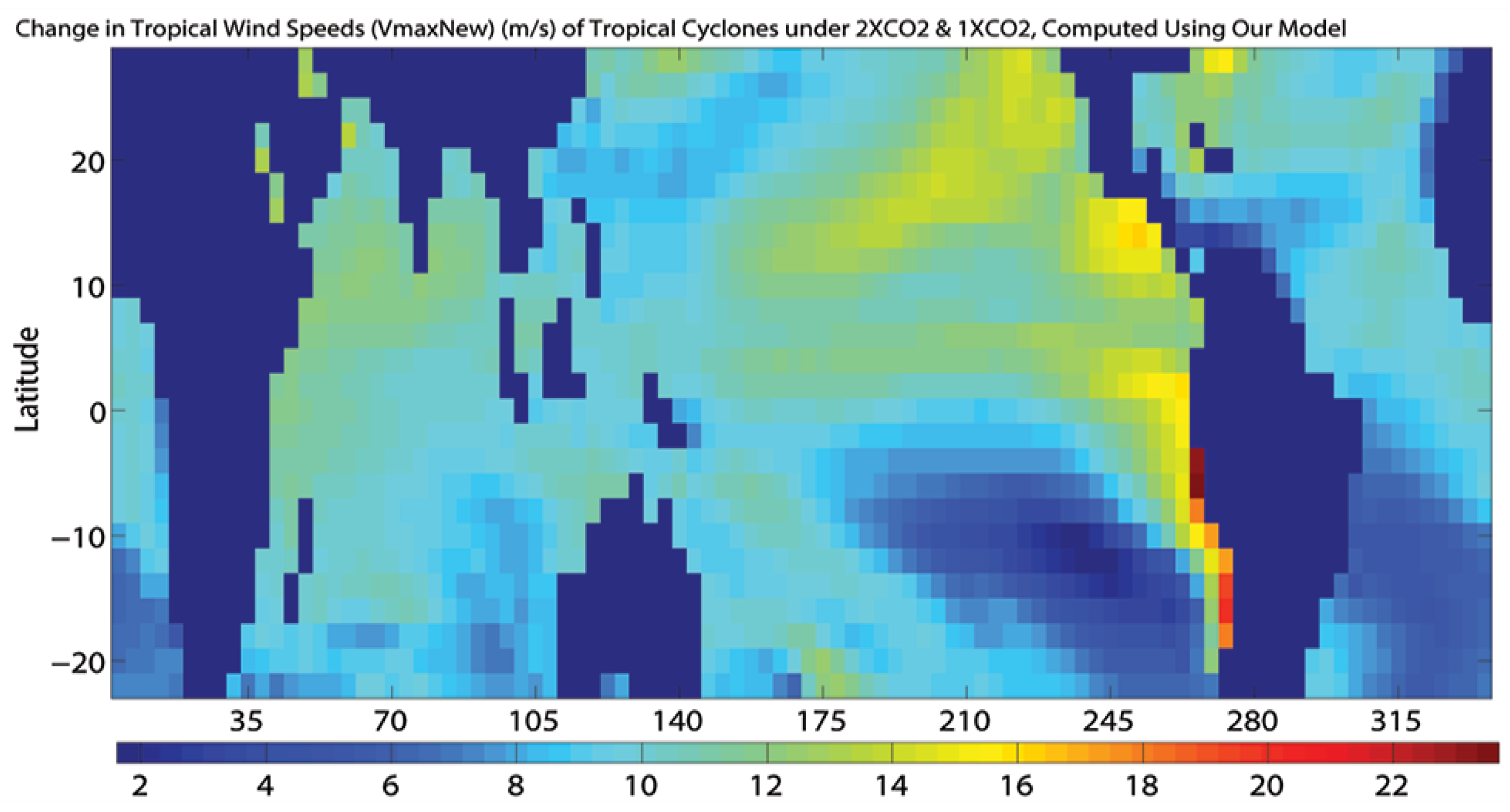
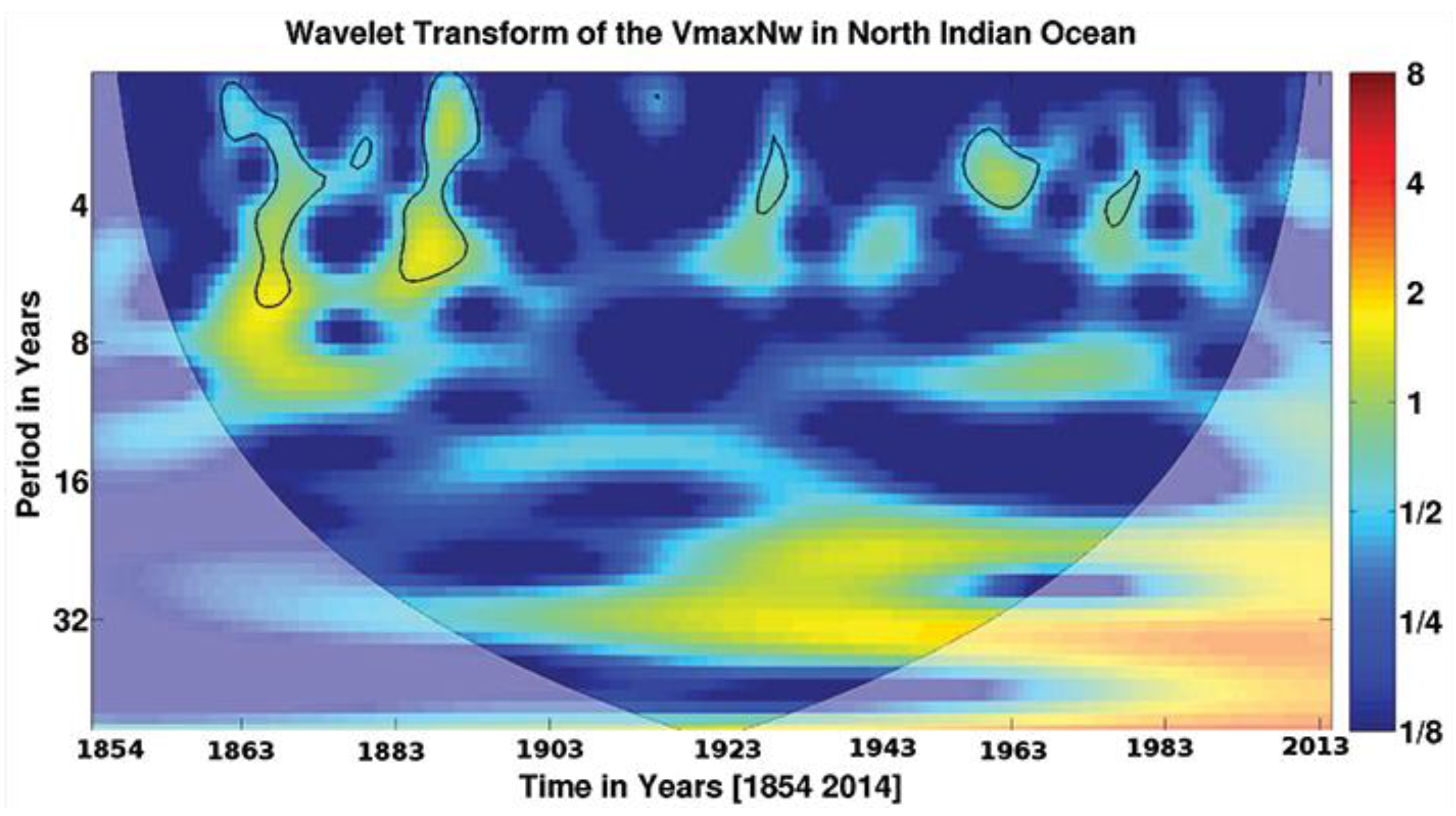
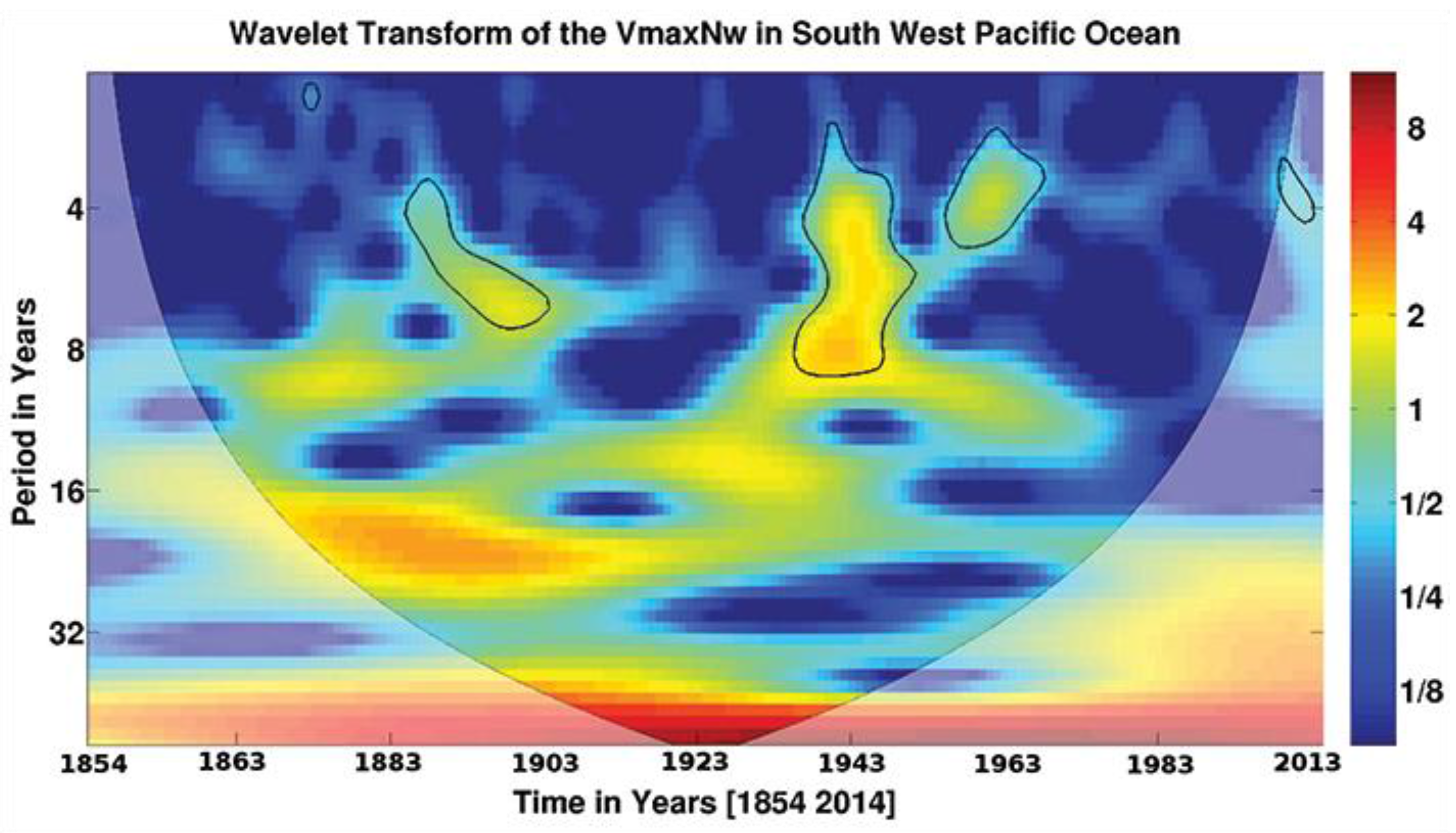
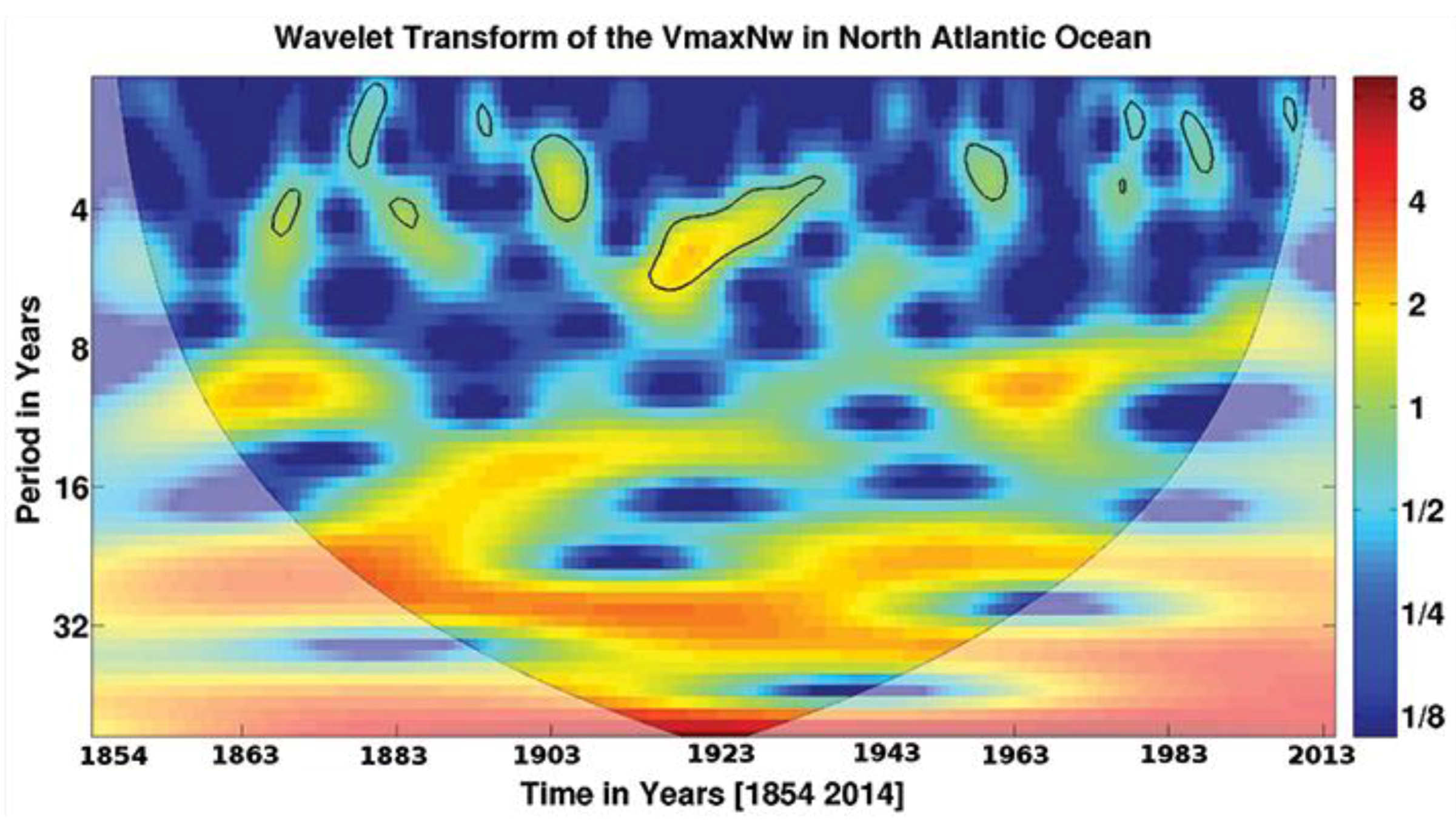

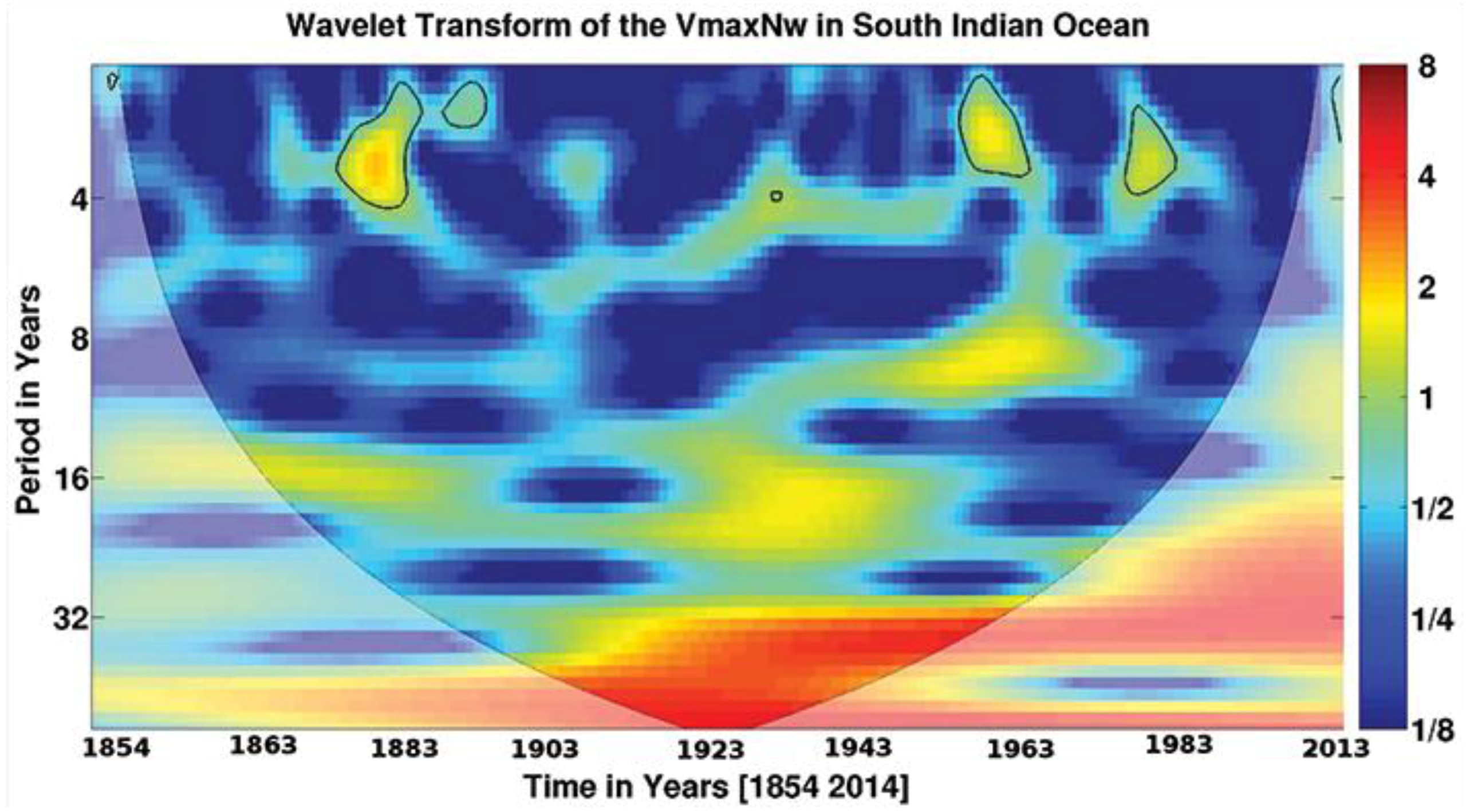
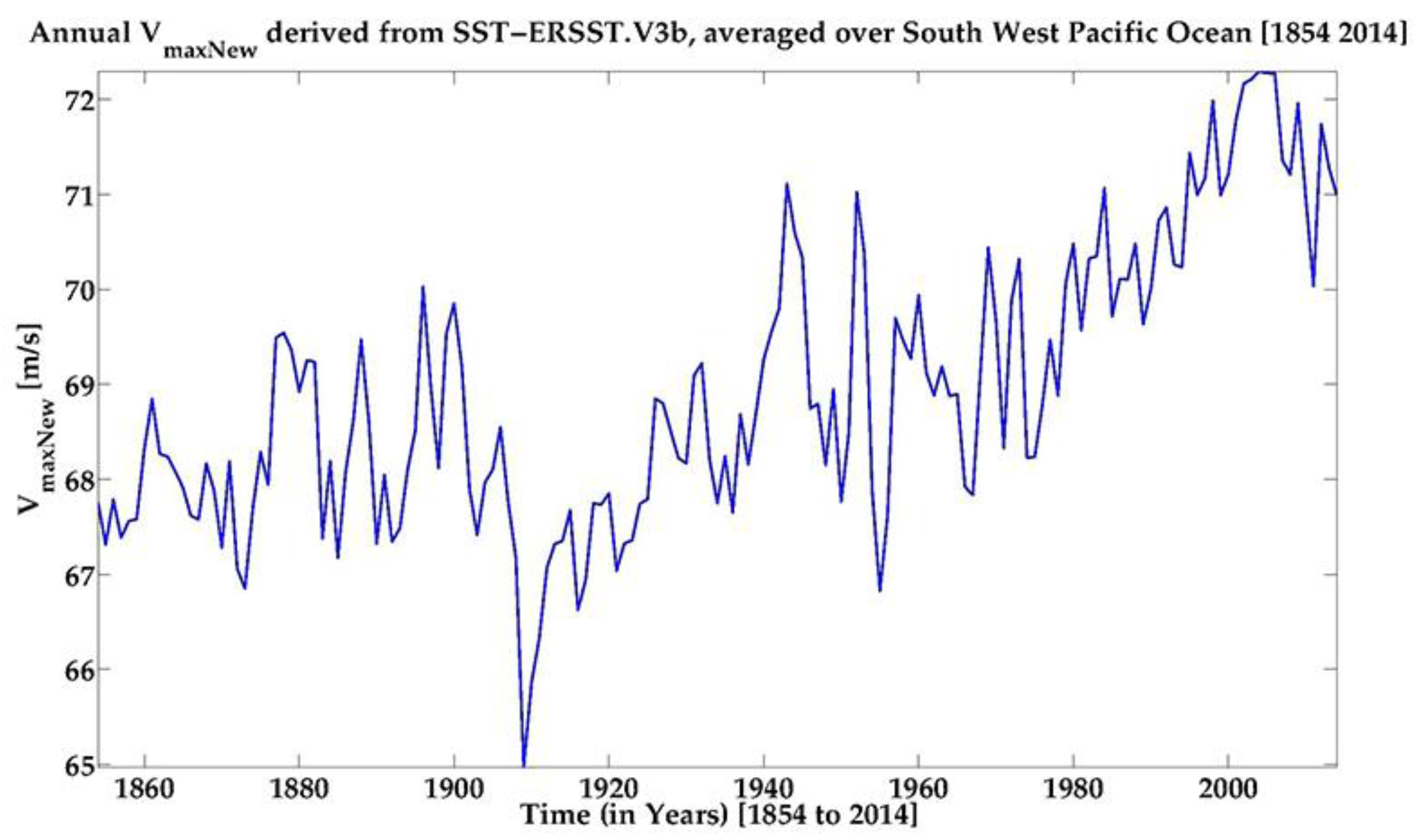
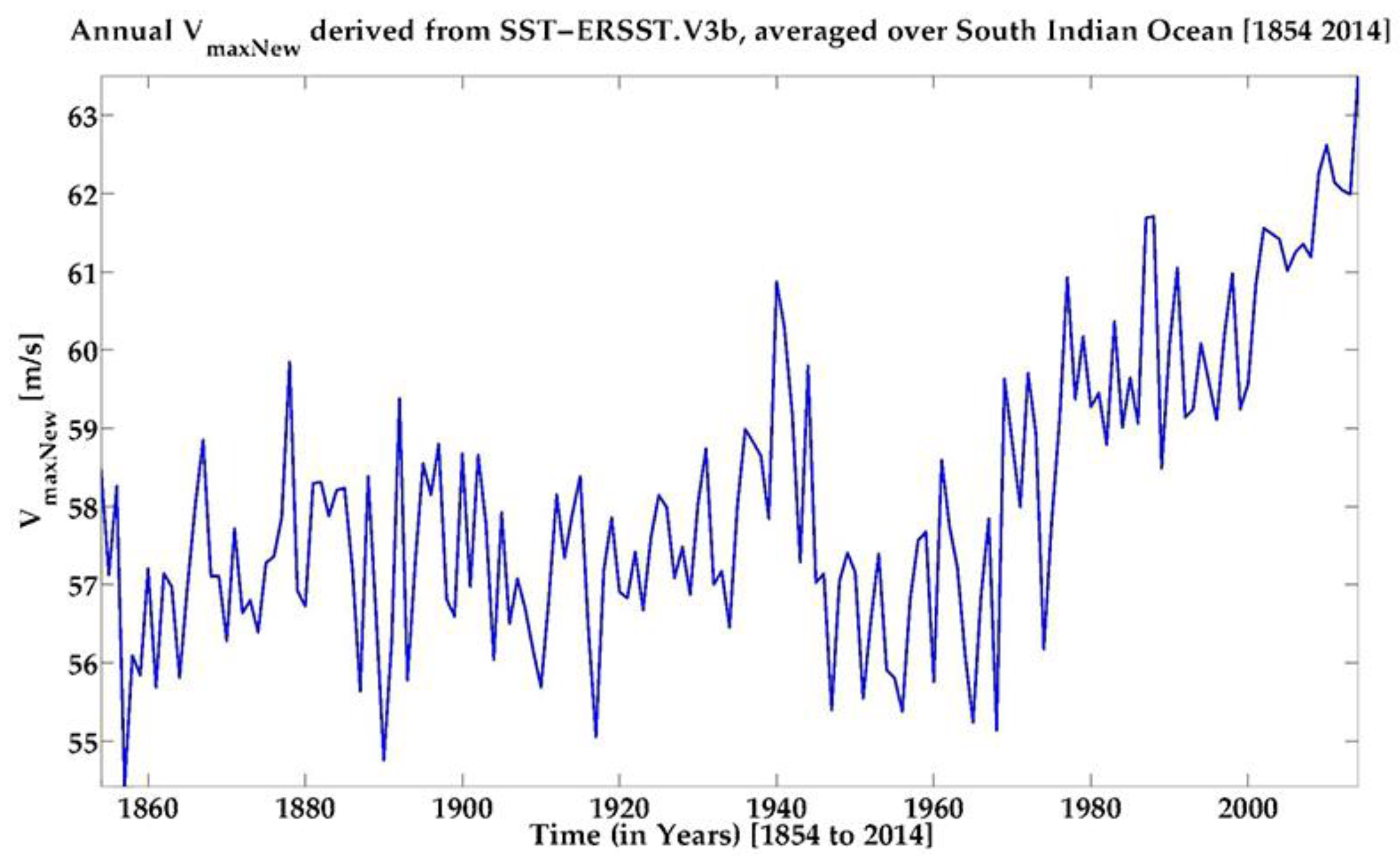



| Vmax (m/s) | Emanuel Implementation (Vmax) | Our Model (VmaxNew) | VmaxNew − Vmax (Validation by Comparison) |
|---|---|---|---|
| COBE SST input | |||
| Minimum | 0.24 | 0.70 | −14.36 |
| Maximum | 94.90 | 92.24 | 38.87 |
| Mean | 66.60 | 69.07 | 2.89 |
| Standard Deviation | 16.51 | 16.86 | 5.35 |
| RMS Difference | -not applicable (n/a)- | -n/a- | 6.08 |
| ERSST.V3b input | |||
| Minimum | 0.24 | 5.64 | −9.84 |
| Maximum | 92.81 | 91.87 | 35.96 |
| Mean | 65.99 | 68.79 | 2.98 |
| Standard Deviation | 16.80 | 16.98 | 5.09 |
| RMS Difference | -n/a- | -n/a- | 5.90 |
| OISST.V2 input | |||
| Minimum | 0.76 | 0.14 | −14.18 |
| Maximum | 99.08 | 93.72 | 39.61 |
| Mean | 66.35 | 70.08 | 4.13 |
| Standard Deviation | 16.45 | 16.93 | 5.40 |
| RMS Difference | -n/a- | -n/a- | 6.80 |
© 2016 by the authors; licensee MDPI, Basel, Switzerland. This article is an open access article distributed under the terms and conditions of the Creative Commons Attribution (CC-BY) license (http://creativecommons.org/licenses/by/4.0/).
Share and Cite
Arora, K.; Dash, P. Towards Dependence of Tropical Cyclone Intensity on Sea Surface Temperature and Its Response in a Warming World. Climate 2016, 4, 30. https://doi.org/10.3390/cli4020030
Arora K, Dash P. Towards Dependence of Tropical Cyclone Intensity on Sea Surface Temperature and Its Response in a Warming World. Climate. 2016; 4(2):30. https://doi.org/10.3390/cli4020030
Chicago/Turabian StyleArora, Kopal, and Prasanjit Dash. 2016. "Towards Dependence of Tropical Cyclone Intensity on Sea Surface Temperature and Its Response in a Warming World" Climate 4, no. 2: 30. https://doi.org/10.3390/cli4020030





